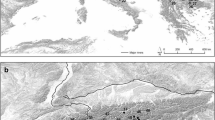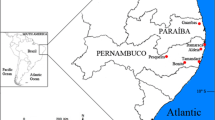Abstract
Relic populations of cold-adapted species, trapped in isolated mountain pockets within the temperate zone, are predicted to suffer considerably due to ongoing climate warming. The butterfly Erebia sudetica sudetica is an example restricted to the Eastern Sudety Mts. Here, the butterfly forms permanent populations on subalpine tall-herb grasslands, but also occupies woodland clearings and hay meadows at lower altitudes. We assume differences among the genetic diversities of the populations due to differences in the temporal continuity of these habitats. Therefore, 17 allozyme loci were analysed for 276 individuals from 13 different localities (six tall-herb stands, two meadows, five forest clearings) in the Jeseník Mts. with a maximum distance of 20 km among them. We obtained a significantly higher genetic diversity for the subalpine populations than for the forest clearing populations. The genetic differentiation among the forest clearing populations was higher than among the subalpine ones. They also showed a significant isolation-by-distance system. These findings support the idea that the lower-elevation populations might have been founded by more than one dispersal event from the subalpine sites, but also secondary colonisations and gene flow in the forest belt. Due to founder effects and possibly further subsequent bottlenecks, these forest clearing populations did not harbour the entire genetic diversity of the taxon. Therefore, conservation actions should focus on the subalpine tall-herb formation.


Similar content being viewed by others
References
Beneš J, Kuras T, Konvička M (2000) Assemblages of mountainous day-active Lepidoptera in the Hruby Jesenik Mts, Czech Republic. Biologia 55:153–161
Britten HB, Brussard PF, Murphy DD, Austin GT (1994) Colony isolation and isozyme variability of the western seep fritillary, Speyeria nokomis apacheana (Nymphalidae), in the western Great Basin. Great Basin Nat 54:97–105
Britten HB, Brussard PF, Murphy DD, Ehrlich PR (1995) A test for isolation-by-distance in central rocky mountain and great basin populations of Edith’s Checkerspot butterfly (Euphydryas editha). J Hered 86:204–210
Brussard PF, Ehrlich PR (1970) The population structure of Erebia epipsodea (Lepidoptera: Satyridae). Ecology 51:119–129
Čížek O, Bakešová A, Kuras T, Beneš J, Konvička M (2003) Vacant niche in alpine habitat: the case of an introduced population of the butterfly Erebia epiphron in the Krkonose mountains. Acta Oecol 24:15–23
Debinski DM (1994) Genetic diversity assessment in a metapopulation of the butterfly Euphydryas gillettii. Heredity 70:25–30
Dieker P, Drees C, Assmann T (2011) Two high-mountain burnet moth species (Lepidoptera, Zygaenidae) react differently to the global change drivers climate and land-use. Biol Conserv 12:2810–2818
Evanno G, Regnaut S, Goudet J (2005) Detecting the number of clusters of individuals using the software STRUCTURE: a simulation study. Mol Ecol 14:2611–2620
Feehan J, Harley M, van Minnen J (2009) Climate change in Europe, 1, impact on terrestrial ecosystems and biodiversity, a review. Agron Sustain Dev 29:409–421
Felsenstein J (2000) PHYLIP (phylogeny inference package) Ver. 3.5.c. Department of genetics. University of Washington, Seattle, Washington
Franco AMA, Hill JK, Kitschke C, Collingham YC, Roy DB, Fox R, Huntley B, Thomas CD (2006) Impacts of climate warming and habitat loss on extinctions at species’ low-latitude range boundaries. Global Change Biol 12:1545–1553
Goudet J (1995) FSTAT (Version 1.2): a computer program to calculate F-statistics. J Hered 86:485–486
Habel JC, Assmann T (eds) (2010) Relict Species: Phylogeography and Conservation Biology. Springer, Heidelberg
Habel JC, Schmitt T (2012) The burden of genetic diversity. Biol Conserv 147:270–274
Habel JC, Zachos FE, Finger A, Meyer M, Louy D, Assmann T, Schmitt T (2009) Unprecedented long-term genetic monomorphism in an endangered relict butterfly species. Conserv Genet 10:1659–1665
Habel JC, Rödder D, Schmitt T, Nève G (2011) Global warming will affect genetic diversity of Lycaena helle populations. Global Change Biol 17:194–205
Harris H, Hopkinson DA (1978) Handbook of enzyme electrophoresis in human genetics. North-Holland, Amsterdam
Harrison S (1991) Local extinction in a metapopulation context: an empirical evaluation. Biol J Linn Soc 42:73–88
Haubrich K, Schmitt T (2007) Cryptic differentiation in alpine-endemic, high-altitude butterflies reveals down-slope glacial refugia. Mol Ecol 16:3643–3658
Heikkinen RK, Luoto M, Leikola N, Poyry J, Settele J, Kudrna O, Marmion M, Fronzek S, Thuiller W (2010) Assessing the vulnerability of European butterflies to climate change using multiple criteria. Biodiv Conserv 19:695–723
Heinrich B (1986) Comparative thermoregulation of four montane butterflies of different mass. Physiol Zool 59:616–626
Jeník J (1961) Alpínská vegetace Krkonoš, Králického Sněžníku a Hrubého Jeseníku: Teorie anemo-orografických systémů [Alpine vegetation of Krkonose, Kralicky Sneznik and Hruby Jesenik: The theory of anemo-orographical systems]. ČSAV, Praha
Jeník J (1998) Biodiversity of the hercynian mountains of Central Europe. Pirineos 151–152:83–99
Junker M, Wagner S, Gros P, Schmitt T (2010) Changing demography and dispersal behaviour: ecological adaptations in an alpine butterfly. Oecologia 164:971–980
Kočárek P (1996) Příspěvek k rozšíření silpha tyrolensis laicharting, 1781 (Coleoptera, Silphidae) v Jeseníkách (Česká republika). [Contribution to the distribution of Silpha tyrolensis Laicharting, 1781 (Coleoptera, Silphidae) in Jeseníky Mts. (Czech Republic).]. Cas Slez Muz Opava (A) 45:51–54
Konvička M, Beneš J, Schmitt T (2010) Ecological limits vis a vis changing climate: relic Erebia butterflies in insular Sudetan mountains. In: Habel JC, Assmann T (eds) Relict species: phylogeography and conservation biology. Springer, Heidelberg, pp 341–355
Kuras T, Helová S (2002) Relict occurrence of the leaf-roller Sparganothis rubicundana in Central Europe (Lepidoptera, Tortricidae). Cas Slez Muz Opava (A) 51:199–204
Kuras T, Beneš J, Konvička M (2001a) Behaviour and within-habitat distribution of adult Erebia sudetica sudetica, endemic of the Hrubý Jeseník Mts., Czech Republic (Nymphalidae, Satyrinae). Nota lepid 24:87–101
Kuras T, Beneš J, Konvička M, Honc L (2001) Life histories of Erebia sudetica sudetica and E. epiphron silesiana with description of immature stages (Lepidoptera Nymphalidae, Satyrinae). Atalanta 32:187–196 + xii
Kuras T, Konvička M, Beneš J, Čížek O (2001c) Erebia sudetica and Erebia epiphron (Lepidoptera: Nymphalidae, Satyrinae) in the Czech Republic: review of present and past distribution, conservation implications. Cas Slez Muz Opava (A) 50:57–81
Kuras T, Beneš J, Fric Z, Konvička M (2003) Dispersal patterns of endemic alpine butterflies with contrasting population structures: Erebia epiphron and E. sudetica. Popul Ecol 45:115–123
Kuras T, Sitek J, Liška J, Mazalová M, Černá K (2009) Motýli (Lepidoptera) národní přírodní rezervace Praděd (CHKO Jeseníky): implikace poznatků v ochraně území [Lepidoptera of the Praded National Nature Reserve (Jeseniky PLA): a conservation synthesis]. Cas Slez Muz Opava (A) 58:250–288
Liška J (2000) An attempt at comparing the lepidopteran fauna of subalpine areas of the High Sudetes. Opera Corcontica 37:286–290
Louy D, Habel JC, Ulrich W, Schmitt T (2014) Out of the alps: the biogeography of a disjunctly distributed mountain butterfly, the almond eyed ringlet Erebia alberganus (Lepidoptera, Satyrinae). J Hered. doi:10.1093/jhered/est081
Matter SF, Doyle A, Illerbrun K, Wheeler J, Roland J (2011) An assessment of direct and indirect effects of climate change for populations of the rocky mountain apollo butterfly (Parnassius smintheus doubleday). Insect Sci 18:385–392
Mazalová M, Dvořák L, Bezděčka P, Kuras T (2009) Čmeláci a pačmeláci (Hymenoptera: Apidae: Bombus) národní přírodní rezervace praděd (Hrubý Jeseník) [bumblebees (Hymenoptera: Apidae: Bombus) of the praded national nature reserve (Jesenik Mts.)]. Cas Slez Muz Opava (A) 58:243–249
Nei M (1972) Genetic distances between populations. Am Nat 106:283–291
Nève G, Pavlíčko A, Konvička M (2009) Loss of genetic diversity through spontaneous colonization in the bog fritillary butterfly, Proclossiana eunomia (Lepidoptera: Nymphalidae) in the Czech Republic. Eur J Entomol 106:11–19
Novák J, Petr L, Treml V (2010) Late-holocene human-induced changes to the extent of alpine areas in the east Sudetes, Central Europe. Holocene 20:895–905
Peakall R, Smouse PE (2012) GenAlEx 6.5: genetic analysis in Excel. Population genetic software for teaching and research—an update. Bioinformatics 28:2537–2539
Pritchard JK, Stephens M, Donnelly P (2000) Inference of population structure using multilocus genotype data. Genetics 155:945–955
Richardson BJ, Baverstock PR, Adams M (1986) Allozyme electrophoresis. Academic Press, San Diego, A handbook for animal systematics and population studies
Roland J, Matter SF (2007) Encroaching forests decouple alpine butterfly population dynamics. Proc Nat Acad Sc USA 104:13702–13704
Rybníček K, Rybníčková E (2004) Pollen analyses of sediments from the summit of the Praded range in the Hruby Jesenik Mts (Eastern Sudetes). Preslia 76:331–347
Saitou N, Nei M (1987) The neighbor-joining method: a new method for reconstructing phylogenetic trees. Mol Biol Evol 4:406–425
Scalercio S (2009) On top of a mediterranean massif: climate change and conservation of orophilous moths at the southern boundary of their range (Lepidoptera: Macroheterocera). Eur J Entomol 106:231–239
Schmitt T, Besold J (2010) Upslope movements and large scale expansions: the taxonomy and biogeography of the Coenonympha arcania—C. darwiniana- C. gardetta butterfly species complex. Zool J Linn Soc 159:890–904
Schmitt T, Seitz A (2004) Low diversity but high differentiation: the population genetics of Aglaope infausta (Zygaenidae: Lepidoptera). J Biogeogr 31:137–144
Schneider S, Roessli D, Excoffier L (2000) Arlequin ver. 2.000: a software for population genetics data analysis. Anthropology, University of Genève
Settele J, Kudrna O, Harpke A, Kühn I, van Swaay C, Verovnik R, Warren M, Wiemers M, Hanspach J, Hickler T, Kühn E, van Halder I, Veling K, Vliegenthart A, Wynhoff I, Schweiger O (2008) Climatic Risk Atlas of European Butterflies. Pensoft, Sofia
Siegismund HR (1993) G-Stat, ver. 3, Genetical statistical programs for the analysis of population data. The Arboretum, Royal Veterinary and Agricultural University, Horsholm, Denmark
Thomas CD, Cameron A, Green RE, Bakkenes M, Beaumont LJ, Collingham YC, Erasmus BFN, de Siqueira MF, Grainger A, Hannah L, Hughes L, Huntley B, van Jaarsveld AS, Midgley GF, Miles L, Ortega-Huerta MA, Peterson AT, Phillips OL, Williams SE (2004) Extinction risk from climate change. Nature 427:145–148
Treml V, Jankovská V, Petr L (2008) Holocene dynamics of the alpine timberline in the High Sudetes. Biologia 63:73–80
Van Swaay C, Wynhoff I, Verovnik R, Wiemers M, López Munguira M, Maes D, Sasic M, Verstrael T, Warren M, Settele J (2010) Erebia sudetica. In: IUCN 2013. IUCN Red List of Threatened Species. Version 2013.1. <www.iucnredlist.org>
Van Swaay C, Collins S, Dušej G, Maes D, López Munguira M, Rakosy L, Ryrholm N, Šašić M, Settele J, Thomas J, Verovnik R, Verstrael T, Warren M, Wiemers M, Wynhoff I (2012) Dos and don’ts for butterflies of the habitats directive of the European union. Nature Conserv 1:73–153
Vandewoestijne S, Van Dyck H (2010) Population genetic differences along a latitudinal cline between original and recently colonized habitat in a butterfly. PLoS ONE 5(11):e13810
Vrba P, Konvička M, Nedvěd O (2012) Reverse altitudinal cline in cold hardiness among Erebia butterflies. Cryo-Lett 33:251–258
Waits ER, Bagley MJ, Blum MJ, McCormick FH, Lazorchak JM (2008) Source–sink dynamics sustain central stonerollers (Campostoma anomalum) in a heavily urbanized catchment. Freshw Biol 53:2061–2075
Wilson RJ, Maclean IMD (2011) Recent evidence for the climate change threat to Lepidoptera and other insects. J Insect Conserv 15:259–268
Wilson RJ, Gutierrez D, Gutierrez J, Monserrat VJ (2007) An elevational shift in butterfly species richness and composition accompanying recent climate change. Global Change Biol 13:1873–1887
Acknowledgments
We thank the administration of the Jeseniky Protected Landscape Area for entry and sampling permits, and logistic support. The study was funded by the Czech Science Foundation (P505/10/1630).
Author information
Authors and Affiliations
Corresponding author
Rights and permissions
About this article
Cite this article
Konvička, M., Mihaly, C.V., Rákosy, L. et al. Survival of cold-adapted species in isolated mountains: the population genetics of the Sudeten ringlet, Erebia sudetica sudetica, in the Jeseník Mts., Czech Republic. J Insect Conserv 18, 153–161 (2014). https://doi.org/10.1007/s10841-014-9621-0
Received:
Accepted:
Published:
Issue Date:
DOI: https://doi.org/10.1007/s10841-014-9621-0




